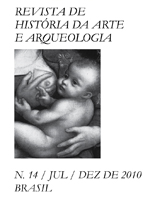Abstract
The presence of crusts of different composition and origin is a threat to cultural heritage. In Brazil, most of the prehistoric paintings are found on rock walls exposed to atmospheric weathering. For this research, samples were taken in the Cavernas do Peruaçu National Park, located in Minas Gerais. The physico-chemical characterization was carried out using thermal analysis, EDS, XRD and FTIR. The analyses indicated the presence of calcium carbonate (CaCO3 ), as a degradation product and showed calcium oxalate (CaC2O4·2H2O) and calcium sulfate (CaSO4·2H2O) in areas where a microorganism grows. This microorganism, probably the lichen Aspicilia calcarea, has already been found in archaeological sites around the globe.
References
AULER, A.; RUBBIOLI, E.; BRANDI, R. 2001. “As Grandes Cavernas do Brasil”. In: Grupo Bambuí de Pesquisas Espeleológicas, Belo Horizonte, 2001.
BRANCO, H. D. O. C.; SOUZA, L. A. C. “Rock art conservation in the Peruaçu valley, Minas Gerais, Brazil”. In: Preprints of the 13th Triennial Meeting of the ICOM Committee for Conservation. Rio de Janeiro, 2002, p. 556-559.
DEI, L.; MAURO, M.; BITOSSI, G. “Characterization of salt efflorescences in cultural heritage conservation by thermal analysis”, Thermochimica Acta, v. 317, 1998, p. 133‑140.
HATAKEYAMA, T.; LIU, Z. Handbook of thermal analysis. Chichester: John Wiley & Sons, 1998.
MARTIN, G.; ASÓN, I. “Arte rupestre pré-histórico en Brasil: la tradición Nordeste”, Revista de História da Arte e Arqueologia, n. 4, 2000, p. 7-26.
PROUS, A.; BAETA, A. M. “Arte rupestre no vale do Rio Peruaçu. Aspectos gerais”, O Carste, v. 13, n. 3, 2001, p. 152-158.
RIBEIRO, L.; ISNARDIS, A. “Os conjuntos gráficos do Alto-médio São Francisco (Vale do Peruaçu e Montalvânia) – Caracterização e sequências sucessórias”. In: Arquivos do Museu de História Natural – UFMG, Belo Horizonte, v. XVII/XVIII, 1996/1997, p. 243-285.
RUSS, J.; KALUARACHCHI, W. D.; DRUMMOND, L.; EDWARDS, H. G. M. “The nature of a whewellite-rich rock crust associated with pictographs in southwestern Texas”, Studies in Conservation, v. 44, 1999, p. 91-103.

This work is licensed under a Creative Commons Attribution 4.0 International License.
Copyright (c) 2021 Journal of Art History and Culture

